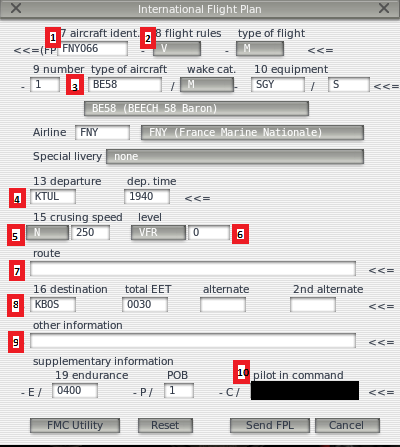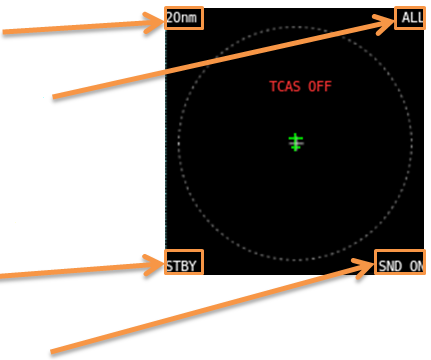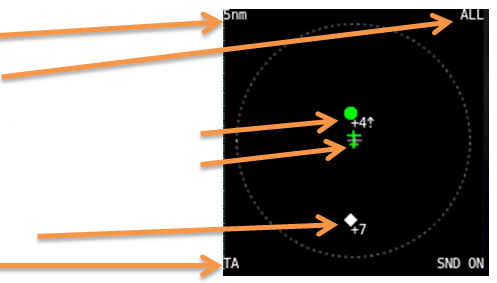¶ INTRODUCTION
The following content will instruct you how to use x-IvAp properly. This is just a short overview of the basics required for the PP exam.
Please note - this document is designed for use with the x-IvAp version which works only with the X-plane simulator.
For a complete explanation and a list of all commands and functions, and for any additional setup instructions, please refer to the latest x-IvAp manual.
¶ GENERAL X-IVAP WINDOWS LAYOUT

In the picture above you can see the pilots’ client after start-up of version 0.3.0
By clicking on the button next to MAIN>, you will find the main display that is used for several entries and notifications. By clicking MAIN> again, you are brought back to the first menu.
The screen you are looking at can be divided into several parts:
- Part which includes the command buttons next to the black screen, 6 each per side. [RED]
- Part which includes the dialog box written in white with black background [YELLOW]
- Part which includes the online/offline status [BLUE]
- Part which includes transponder information [VIOLET]
- Part which includes the action buttons [GREEN]

¶ STATUS LIGHTS
On the right hand side of the client, four status lights can be found which provide information about important factors:
- FP status indicator: it is ERR when no flight plan has been sent yet and will change to SENT once the flight plan is sent.
- NET status indicator: it is CONN if the connection between x-IvAp and the IVAO network is successful and DISC if it is not.


¶ TRANSPONDER
Above the status lights is the transponder section which includes:
- Four digits black window indicating your present squawk code.
- The ID or IDENT button must only be used after ATC has instructed you to do so. This function makes your radar target flash on the controller’s radar screen. The ATC will instruct a pilot to click that button by saying the phrase “SQUAWK IDENT”.
- A switch to toggle the status from standby (“STBY”) to active (“TX”).


Be aware that when flying, you must set this toggle switch to STBY when you are on the apron or on taxiways (taxiing, on gate) and to TX when you are on the runway and flying
¶ ACTION BUTTONS
In the bottom right of the IvAp window, there are two action buttons:
- TCAS button: TCAS stands for Traffic Collision Avoidance System. By clicking on the button, a new small window opens, simulating a TCAS window (see next chapter for a TCAS presentation)
- CONN button: used to connect to or to disconnect from the IVAO Network (called IVAN).

¶ DIALOG BOX LAYOUT AND COMMAND BUTTONS
This display shown below is the MAIN display window of x-IvAp.

¶ THE UPPER PART
The upper part includes:
- 2 VHF frequencies VHF1 and VHF2
- <T/R> indication which indicates which frequency is currently active (Transmit/Received)
- ACARS> button that opens another menu (see next chapters)
- SYSTEM> button that opens the parameter menu (see next chapters)

¶ THE MIDDLE PART
The middle part between the two dashed lines is a log and chat window for several outputs, such as:
- Text radio communications from a pilot or an ATC
- controller requests to contact him
- UNICOM message
- Server and Broadcast Messages for all members

All messages displayed in red are private chat messages. They do not originate from any frequency.
¶ THE LOWER PART
The lower part is an input area for text input, also called the ‘scratchpad’. There are many possibilities for use of this zone:
- Interact on frequency by typing your messages in.
- Interact with software by using text commands. These commands are initiated by using a dot “.”, followed by the command letter, then your message

Be aware that x-IvAp automatically inserts your call sign before your message in x-IvAp.
Here are the most important and most used commands for the x-IVAP scratchpad:
- Send a private message: .msg <callsign> <message> or .m <callsign> <message>
- Reply to last private message: .r <message>
- Open a chat window: .chat <callsign>
- Set frequency on active COM1 radio: .c1 <frequency>
- Set frequency on active COM2 radio: .c2 <frequency>
- Change transponder code: .x <4 digit squawk code>
- Request METAR of an airport: .METAR <ICAOcode>
- Request TAF of an airport: .TAF <ICAOcode>
- Request ATIS of an ATC unit: .atis <ATCunit>
- Inform all online supervisors: .wallop <message>
- Disable voice (while connected): .novoice
- Enable voice (while connected): .voice
- Set primary altimeter to barometric value: .QNH <QNH> or .ALT <Altimeter>
¶ RADIO FUNCTIONS
In the MAIN x-IvAp window, you will find the radio communication button and relevant feedback:
- There are 2 VHF frequencies. One active and one Stand-by. The active frequency is indicated with the <T/R> active sign.

If you left click on the button with your mouse, you can change the frequency value using the communication selection window. If you see <T/R> in front of the previous frequency, this means that this channel is the active radio channel. In the communication window, you will find a list of available ATC positions with their frequencies.

Just left click on your selected ATC, to change the frequency (example: LFCR_APP). You can use the previous page or the next page button in order to browse the ATC list.

In x-IvAp, you have two different frequencies COM1 and COM2, if you do not see <T/R> in front of the previous frequency or ATC, this frequency is considered as a standby communication frequency.
Just left click on ACT COM2, in order to set COM2 as the active frequency.

¶ SUB MENUS ACARS
Definition: ACARS is Aircraft Communication Addressing and Reporting System.
¶ ENTER IN ACARS PAGE

By clicking on the button next to ACARS> in the MAIN screen, a new menu with several options appears:
¶ GET METAR AND TAF INFORMATION
You can get your departure and arrival airports’ METAR, by clicking on the first or second button next to the corresponding ICAO code of these airports.

And another method: Insert an ICAO airfield code into the scratchpad (example: KJFK) Click the proper <REQ button. Then, you will receive a TAF, SHORTTAF or a METAR.

Pay attention that TAF and SHORTTAF are available only at some large airfields.
¶ GET THE ATIS FROM AN ACTIVE ATC
You can get the ATIS from an active ATC:
- Insert the active ATC position into the scratchpad (example SBUL_APP)
- Click the RQ ATIS> button

¶ SEND FLIGHT PLAN
The SEND FPLN> button will open a new window in which the flight plan must be completed.

The figure below shows an empty flight plan to complete (consult the flight plan documentation for further details).

Here are the main points:
- Your chosen call sign (radio title of your aircraft)
- Your flight rules and type of flight
- Your aircraft code (ICAO) and its wake turbulence category
- Departure airfield ICAO code
- True air speed (N=knots, K=km/h) expected en route
- Altitude or flight level (feet/100 or FL)
- Route
- Arrival airfield ICAO code
- Remarks
- Your real name (rules and regulation IVAO)
You must complete your flight plan before connecting to IVAO.
¶ TCAS
A traffic collision avoidance system or traffic alert and collision avoidance system, both abbreviated as TCAS (pronounced tee-kas), is an aircraft collision avoidance system which monitors the airspace around an aircraft for other aircraft equipped with a corresponding active transponder, independent of air traffic control, and warns pilots of the presence of other transponder-equipped aircraft which may present a threat of a mid-air collision.
In x-IvAp windows, TCAS can be activated using the TCAS button on the interface

A new window opens and shows a deactivated TCAS with message “TCAS OFF” like the image below. In this window, there are 4 zones where users can click using the mouse in order to change the TCAS parameters highlighted in the picture below with orange rectangles.

This zone can change the horizontal range of the TCAS. Possible values are:
3, 5, 10, 20 or 40 NM
This zone can change the vertical visibility range of the TCAS. Possible values are: ALL, NORM, BLW, ABV.
NORM= all traffic from your current altitude ± 2700ft is displayed. ALL = all traffic is displayed. ABV = all traffic from your current altitude -2700ft to +9000ft is displayed. BLW = all traffic from your current altitude -9000ft to +2700ft is displayed.
This zone can change the state of the TCAS system: STBY=OFF, TA=ON (traffic advisory), RA=ON (resolution advisory)
This zone can switch the sound STATUS, sound ON or OFF.
Now, with this new image, we can see:

- 5NM range
- All traffic is displayed (no altitude filtering)
- One aircraft in traffic advisory (green dot) at +400ft and climbing↑
- Your aircraft position representation (little green aircraft symbol)
- Another close aircraft at +700ft (white sign)
- TCAS is ON in Traffic advisory mode
¶ X-IVAP CONFIGURATION FILE
For better performance, the file “x-ivap.conf”, which can be found in subdirectory “X-Plane 10\Resources\plugins\X-IvAp Resources” or “X-Plane 11\Resources\plugins\X-IvAp Resources” shall be modified and add the following new parameters:
[PREFERENCES]
PRVTMSGSOUND=1
TAGGING=1
MULTIPLAYER=1 WEATHER=1
DARK=1
VOICE=0
FIXEDWINDLAYER=1
MAXVISIBILITY=80000
TURBULANCE=15
[PLANE]
RESOLUTION=8
FIXEDWINDLAYER =1
When this is set to 1, x-IvAp uses the middle wind layer of the FSD and lets x-plane interpolate the wind speed/directions during climb/descent. If this is set to 0, x-IvAp updates the middle wind layer , but the updates during descent/climb depending are sometimes far behind the actual plane's altitude.
TURBULANCE = 15
With this parameter, the user can regulate the amount of turbulence coming from FSD. Actually this is a x-plane 10/11 problem, with standard value of 4 you might crash during climb or descent in a cloud. A value of 15 is better.
MAXVISIBILITY=80000
User can set the max visibility to max 100 KM. (was 40 km)
RESOLUTION=8
Set this to 8, gets the best performance of the CSL models. (Other planes)
You can add also these parameters
MESSAGESVISIBLE=1
Set 0 or 1. Enable to show text messages in upper right corner. Useful for reading text messages, when main plugin's window is hidden
MESSAGESSHOWDURATION=5
Set time in seconds for showing text messages in upper right corner.
¶ SEE ALSO
- None
¶ REFERENCE
- None
¶ AUTHOR
- VID 150259 - Creation
- VID 256272 - Wiki Integration
- VID 346148 - Wiki Migration
¶ COPYRIGHT
- This documentation is copyrighted as part of the intellectual property of the International Virtual Aviation Organisation.
¶ DISCLAIMER
- The content of this documentation is intended for aviation simulation only and must not be used for real aviation operations.